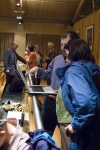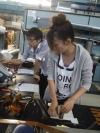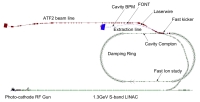 |
|
|
 |
ILD community determines parameters for reference detector

Discussions during the ILD meeting in Cambridge, UK, about the detector concept parameters continued in the coffee breaks...
(Photo: DESY) |
“I know it is painful — nobody expected it to be fun,” Ties Behnke, standing in front of a detector audience in a lecture hall at Cambridge University, summed up the at times rather heated discussions at the ILD meeting two weeks ago. “But we are making progress and it actually turned out to be fun!” The scientists working on the International Large Detector concept ILD had met for the second time this year to discuss the set-up of their future masterpiece.
The ILD group formed about a year ago from the former GLD and LDC detector concept groups. Both concepts had their plans for trackers, calorimeters and the detector set-up as a whole. “This was actually a birthday of ILD. We have been working on two different detector concepts up to this meeting. Now, we have a single concept to work on,” said Hitoshi Yamamoto. They have also agreed to have a single software framework managed jointly.
The deadline for submission of a common Letter of Intent (LOI) is in March 2009, and many parameters have to be set before work can start in earnest.
Read more...
-- Barbara Warmbein |
 |
|
|
 |
Upcoming meetings, conferences, workshops
Workshop on Sources of Polarized Electrons and High Brightness Electron Beams (PESP 2008)
JLab, Newport News, Virginia, USA
1-4 October 2008
EUDET Annual Meeting 2008
Nikhef, Amsterdam, The Netherlands
6-8 October 2008 18th International Symposium on Spin Physics (SPIN 2008)
University of Virginia, Charlottesville, VA, USA
6-11 October 2008 CLIC08 Workshop
CERN
14-17 October 2008
Joint Workshop on Detector Development for Future Particle Physics and Photon Science Experiment
DESY Hamburg, Germany
16-17 October 2008 2008 IEEE Nuclear Science Symposium and Medical Imaging Conference
Dresden, Germany
19-25 October 2008 TTC Meeting
New Delhi, India
20-23 October 2008
Upcoming school
Third International Accelerator School for Linear Colliders (2008 LC School)
Oak Brook, Illinois, USA
19-29 October 2008
|
|
|
GDE Meetings calendar
View complete ILC calendar
|
|
|
 |
World beam test tour at Fermilab

Students working on assembling and testing |
The International Linear Collider requires a detector with excellent performance to fully exploit its physics potential. In order to meet this challenge, significant improvements in the calorimetric performance are needed compared to previous generations of detectors, and new technologies and techniques are being developed. To test those technologies and techniques with particle beams, scientists are travelling around the world, to where beamlines with particle beams for tests are available.
Read more...
-- Rika Takahashi |
 |
|
|
 |
From Nature
2 October 2008
Independent panel passes judgement on UK physics
Wakeham review praises state of discipline and recommends ways it can move forward.
...The panel did recommend that more could be done to protect funding for particle physics and astronomy. In particular it suggested that the council appeal to the government for additional funding for particle physics and astronomy to "avoid the undesired tensioning of these grants and facilities support against national facilities".
Read more...
|
|
From Nature
2 October 2008
Commentary: UK physics gets a health check
The field is healthy, says Bill Wakeham, but scientists need to reclaim the intellectual ownership of research at the margins of the discipline such as medical or atmospheric physics.
Read more...
|
|
From The Times
2 October 2008
Britain's reputation as physics leader 'harmed by £80m crisis'
... That echoed the MPs' report, which said that pulling out of projects such as the International Linear Collider, a next-generation atom-smasher that would succeed the Large Hadron Collider, had made Britain appear to be an “unreliable and incompetent” international partner.
Read more...
|
|
From Physics World (20th anniversary issue)
1 October 2008
Editorial: Two decades and counting...
...It will be intriguing to think what my successor in 20 years’ time — assuming that Physics World still exists — will make of this status report. By then, practical quantum computers could well be used for research and high-temperature superconductors will be common in power cables. The International Linear Collider is likely to be up and running, and fusion power should be nearing as a commercial reality.
Read more...
|
|
From Science & Vie
(print edition)
September 2008
Le LHC aura-t-il un successeur ?
...Suspendue aux résultats du LHC, la décision de maintenir l'ILC ou de se tourner vers le Clic devrait être prise vers 2010-2012. Le choix ne sera pas que scientifique : les arbitrages financiers et politiques pèseront aussi de tout leur poids.
|
|
From Interactions.org
29 September 2008
The “Magnificent Seven” of European astroparticle physics unveiled to the world
...To insure the coordination of astroparticle physics at the European level, research agencies from 13 countries joined their efforts within the ASPERA European network.
Read more... |
|
From Science News
26 September 2008
Galaxies on the move
A newly discovered "dark flow" appears to carry clusters of galaxies toward a point in the southern sky, a new study suggests.
Read more... |
|
From AFP
26 September 2008
Cern : inauguration du LHC maintenue au 21 octobre en dépit de la panne
...Les chefs d'Etat et de gouvernement des vingt Etats européens membres de l'organisation ont été invités mais le Cern ignore encore qui d'entre eux sera présent à Genève pour l'occasion.
Read more... |
|
From argenpress.info
25 September 2008
El acelerador de partículas LHC. Avance científico y estratégico europeo
... el Colisionador Lineal Internacional [...] opera con principios similares al LHC. Pero así como éste esta diseñado para 'descubrir' y abrir nuevas áreas de la Física, el ILC será diseñado para explorar detalladamente los descubrimientos que haga el LHC.
Read more... |
|
|
 |
 |
|
|
 |
Achieving tiny beam spot sizes with ATF2

The layout for the ATF and ATF-2 at KEK |
The ILC's beams pass through each accelerating element once before they are directed to collide with the beam travelling in the opposite direction. This poses the two main challenges in the ILC: to achieve a very high gradient in the accelerator in order to make it as short as possible while achieving the desired energy, and to achieve very small beam spots to maximise the probability of collisions by the crossing beams. The process of creating small beam spots relies on creating low-emittance beams, preserving the emittance during acceleration and transport, and focusing the beams to nanometres just before collision. Last month I had the opportunity to visit the Accelerator Test Facility (ATF) at KEK which creates small emittance beams that will be injected into ATF2, a final-focus beamline that will test the ability to bring the beam to the nanometre-scale beam spot sizes needed for the ILC.
Read more...
-- Barry Barish
Director's Corner Archive |
 |
|
|
 |
Barry for Vice President
The members of the American Physical Society APS have elected ILC GDE Director Barry Barish as their next vice president. He will start in January 2009 and become president-elect in 2010 and president in 2011. He was also re-elected to the US National Science Board, an independent body of advisors to both the US President and Congress on broad national policy issues related to science and engineering research and education and an
oversight body for the National Science Foundation (NSF). The term will last six years.
ILC Note
2008-048
The Linear Collider TPC: Revised Magnetic-field Requirements
arXiv preprints
0809.4485
Precision Polarimetry at the International Linear Collider
0809.4111
A Handy Tool for History Keeping of Geant4 Tracks -- J4HistoryKeeper --
|
|

